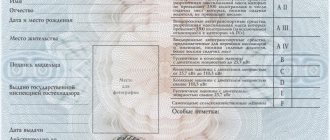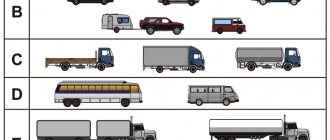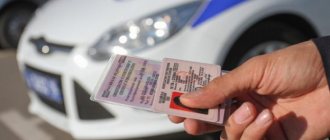As it turns out, training in a driving school goes very quickly for many and the day is just around the corner when you have to go to the traffic police department in order to begin taking the exams. To begin with, this will be passing state exams on knowledge of the Rules of the Road, and then, if successful, testing your driving skills.
In today's material we will talk about how to pass the traffic police exam the first time. In such a life situation, there is actually nothing complicated, you just need to know certain and logical rules, as well as some tricks and subtleties that will help you pass your license the first time and without problems.
The traffic police exam itself includes three stages: knowledge of the theory of traffic rules, driving on a race track and driving in urban conditions.
Theoretical exam
The first step on the path to obtaining a driver's license is passing a theoretical exam on knowledge of the rules of the road. Initially, it is worth paying attention to the following points:
- Knowledge of traffic rules theory. Of course, the basis for successfully passing the theoretical exam is a confident knowledge of the rules of movement themselves. There is no need to reinvent the wheel here and you will need to start cramming. This is necessary so that during the exam itself you do not get confused in the formulation of such fundamental concepts as “vehicle”, “overtaking”, “intersection”, “main road”, “pedestrian” and others;
- Ability to use computer equipment. When passing, it is important not to be nervous, not to wave your hands, as you can simply press a random button on the keyboard and ruin your grade. Focus on your work and don't get distracted while answering a question;
- A person’s ability to behave when taking an exam. When taking an exam, you should not contact the examiners over trifles, you should not chat or talk over each other, and certainly not behave defiantly.
And one more simple piece of advice: you don’t need to take any sedatives before taking the exam, even if you are very worried.
It’s better to do breathing exercises – it definitely won’t do any harm. After all, even if sedatives help you at the first stage of the exam, then at the second and third stages you will need maximum concentration plus a good reaction. But if you take any sedative medications, problems may arise with this.
At the stage of preparation for the theoretical exam in the traffic police, this practice has proven itself quite well: solving exam papers online. This online testing can be completed directly on our website in the “Online Traffic Rules Exam” section. Testing your knowledge of traffic rules via the Internet will consolidate your theory and sharpen your computer skills when taking the test.
At the first stage of the exams, everything, in general, everything depends only on the candidate, so how to pass the traffic police exam the first time should be easy to overcome in terms of theory.
Learn rhymes and make abbreviations
How much easier it is to remember information encrypted in the form of abbreviations or short poetic forms, everyone has been aware of it since childhood. Remember “Every Hunter Wants to Know...”? This is called associative memory and is used in mnemonics. It is also applicable in the study of traffic rules.
A simple example. During the theoretical exam, applicants often fail on questions about the interpretation of traffic controller signals. Let's say the traffic controller stands sideways to you, pointing his baton to your left. Is it possible to drive straight or do you have to turn in the direction indicated by the rod? What about making a right turn in this situation? Indeed, this is where you can get confused. And you can remember a little poem:
If the stick is facing your mouth, make a right turn.
If the stick points to the right, you have no right to drive.
If the stick points to the left, you are the queen of the road.
You can't ride on your chest or back - it's a wall!
“Queen” means you can go in any direction.
Abbreviations are also a popular way to remember something. For example, when taking a driving test, it is important to remember the USSR rule: C - light, C - clutch, C - speed, P - handbrake. This means that before moving off, the driver must: turn on the low beam, depress the clutch, engage first gear (speed), and release the car from the handbrake. Violation of this sequence is fraught with a failed exam.
And, of course, don’t forget one of the key rules: the rule of three Ds or DDD. It stands for this: give way to the fool. That is, if one of the road users breaks the rules, others will have to do everything possible to prevent an accident. By the way, the three D rule describes another way to successfully pass a theoretical exam.
Driving on the circuit
At the driving stage, the risks become much higher. In fact, this is where the exam really starts. After all, as life shows, practice is the criterion of truth. The race track becomes the first place for a real demonstration of practical driving skills.
There are a number of common mistakes that can very well lead to unsuccessful results.
- First: do not try to drive the car tightly, pressing against the racks. There’s no point in demonstrating how perfectly you feel about the car’s dimensions.
- Second: there is no need to rush. Of course, fines are not imposed for “recklessness,” and this may not lead directly to failure of the exam. But for such tricks, the inspector will draw in his mind an extra minus for you. In addition, in any situation there is more time to react when the speed is low.
- Third: when doing the “entering a box” or “parallel parking” exercise, be sure to park the car level! By stopping within a certain zone, it is possible to earn a positive point even when the car is not quite level. But there is such a nuance: if you park the car unevenly, you will show that you cannot use the rear-view mirrors to the fullest, and you also have problems using the steering wheel. All this means that such a management style can easily lead to an accident in the city, and the examiner will even try to prevent such a candidate from entering the third stage of the knowledge test! It is quite possible that the inspector will use all his nagging and tricks during the exam, so much so that you will not be able to pass the exam in any case.
Even if you succeed in passing the race track, at the third stage the inspector will probably find an opportunity to “fail” such a sloppy driver candidate. If you have a persistent desire to get your license quickly and pass the traffic police exam the first time, just listen to our simple but vital advice.
It is clear that the future driver will have to perfectly use all the techniques and elements of driving. But driving schools don’t always devote enough time to practicing driving lessons.
The advice is this: if you still have some gaps in your driving skills, try, if possible, to practice driving additionally, even before the traffic police exams begin.
Driving in the city
The third part of the exams is the most difficult part - this is where most of the failures occur when passing the license. This is precisely why city driving poses the greatest difficulties when passing the traffic police exams. Of course, if the city is small, you can know in detail the features of all the streets, some of the tricks that traffic police officers use, complicating the tasks of future drivers. But what if you live in a large metropolis where it is difficult to determine your future route during the exam?
The conclusion follows from this: you need not only to know the rules of movement as much as possible, but also, in addition, to quickly be able to apply them in practice, focusing on the examiner’s commands. This is the only way to really justify any actions you take while driving. Many traffic police officers actually positively consider the convincing arguments of the future driver, so if he is confident that he is right, a polite explanation to the inspector can really solve the situation in favor of the student. It is no secret that there are situations when an inspector deliberately provokes traffic violations in order to assess the driver’s adequacy or with the intention of deliberately “flooding” him. Be alert and do not give in to such wishes!
A story from life. Two young friends took the exam on the same day. One succeeded, the other did not. The route section was the same for both. The first friend passes, he’s doing fine, and then the examiner tells him to stop. A man stops a car. The inspector tells him: “You didn’t pass. Stop on the bridge." The candidate signs, gets upset and leaves. Well, then I went for a retake. Second friend rents, same route, same situation, bridge. The inspector again stands his ground: “They didn’t pass. Stop on the bridge." The person does not get lost and says: “Why? Three lanes means you have the right to stop. Clause 12.4 of the rules says that stopping is prohibited in tunnels, at crossings, overpasses, bridges when traffic in a given direction has less than three dividing lanes.” The inspector thought for a moment and said: “Well done, you passed.” The very next day, one of the friends had a license, and the other without. This is the kind of knowledge of traffic rules that came in handy when passing the exam. Learn materiel!
When preparing to take your driving test within the city, pay special attention to the following sections of the traffic rules:
- passage of a pedestrian crossing;
- passing public transport stops;
- stopping a car within the city;
- overtaking rules;
- lane change rules;
- sequence of crossing an intersection;
- left turn, U-turn.
Recommendations for the traffic police exam
These simple steps will help you successfully pass all stages of the traffic police exams. You need to not only learn and understand the educational material, but also feel confident at all stages of the exam marathon. General simple tips:
- Shoes and clothing should be as comfortable as possible, especially during the cold season. It is advisable to carry out all preliminary training trips in the same equipment that you will wear during the exam.
- Take only the most necessary documents and things to the exam. It is better to leave handbags, purses, umbrellas, and other accessories at home. In addition to the fact that they will distract and interfere, they can also be forgotten somewhere in a state of nervous tension.
- Before starting and moving the car, adjust the seat position. This simple point is very important, so feel free to do it without fear of the inspector’s reaction. If the driver's feet do not reach the pedals, the path may be dangerous and short.
- Be sure to fasten your seat belt before driving. By the way, the same maneuver can be required from the traffic police inspector.
- Remember to use the handbrake when stopping on an incline. When starting the car, you need to simultaneously release the handbrake, adding engine speed with gas.
- Headlights. If the car is not equipped with daytime running lights, turn the headlights to low beam. If you are not sure whether the car has daytime running lights, turn the headlights on low beam anyway. It definitely won't get any worse.
- Before you start driving, turn on the car's left turn signal and look in the rearview mirrors. Movement can only begin if all obstacles are clear. Clearly express a backward glance by turning your head, which will be further evidence of such a glance for the inspector.
- If possible, show that you can drive the car using all gears. If possible, go to fourth gear.
- Try to pass the exam at the beginning, one of the first. As life shows, among the first candidates the majority of those who passed. After the first ten, the examiner realizes that enough people have already passed and the flow of “success” ends.
It is quite possible to pass the traffic police exam the first time; it is important to learn the rules as much as possible, to be able to quickly apply them in practice, without succumbing to the examiner’s tricks. Many inspectors react positively to convincing arguments from driver candidates - explain and defend your decisions calmly and constructively. If something went wrong and the first attempt failed, this is not a reason for frustration. Identify your weaknesses, learn some more, and go into your second attempt with optimism. Surely it will turn out better and more successful than the first one. Good luck!
How to quickly learn traffic rules: advice from experienced psychologists
How to quickly learn traffic rules? Are there any techniques that allow you to quickly and effectively remember all the rules and feel confident not only during the traffic police exam, but also in real conditions on the road?
Studying the rules of the road (traffic rules) is one of the main stages of training for novice drivers. It’s the responsibility of everyone who plans to get behind the wheel to know them—there’s no way around it.
Although, at first glance, brochures with rules do not look like thick tomes, they contain a lot of different information, and sometimes learning and assimilating it becomes quite a difficult task. Therefore, the logical question is: how?
Spy on drivers
One of the simplest ways to learn traffic rules is to observe how the driver driving you behaves on the road. For example, in public transport it is better to choose the front seats so that you can see the road and the actions of the driver.
Every time you drive through an intersection, change lanes, brake, or park at a stop, it is important to analyze what the driver is doing and compare this information with known traffic rules.
If some maneuver turns out to be unclear, memorize it and later, during a driving lesson, model it in front of the instructor to get a clear explanation. It will be remembered much more firmly than dry information from a book about traffic rules.
How to quickly learn traffic rules? There is nothing simpler...
So, friends, if you are interested and have really wondered how to quickly learn the theory of traffic rules, then read on.
In fact, the techniques that we will talk about today can be successfully used to study any other information. We will look at the following memorization methods:
- visualization method;
- association method;
- mnemonic method;
- development of characteristic thinking - in our case, we learn to think like a driver;
- use of simulators and other special programs.
Let's visualize
The first option, as you might have guessed, is based on visual memory. It is ideally suited for memorizing numerous road signs, and there are about 200 types of them in traffic regulations.
At first it may seem that the signs are all different, but in fact the color and shape of the signs indicate belonging to a certain group, namely:
- prohibitory - the strictest, round, red stripe in a circle, white or blue background. These include the legendary “brick” sign;
- prescriptive - these signs are also round, but with a completely blue background; their implementation is no less mandatory than the previous group. For example, they indicate how to move at an intersection, where to turn, and so on;
- warning signs - these signs are triangular with a red border. They notify the driver that there is something ahead that requires increased attention, for example, a sharp turn, descent, ascent, narrowing of the road, railroad crossing, etc.;
- informational - blue background and rectangular or square shape. Their name speaks for itself - they let the person driving, as well as pedestrians, learn about something important. For example, such signs notify about the location of a pedestrian crossing, a public transport stop, the distance to a populated area, etc.
There are exceptions to this diversity. For example, a diamond-shaped “main road” sign or an inverted triangle “give way”, but there are few of them and they are easy to remember
Connecting associations
Well, we are getting closer to finding out how to learn traffic rules quickly and efficiently. And the next assistant in mastering this difficult material will be the method of associations.
Its essence is to tie their meaning to the familiar rules of associations close to you - this greatly simplifies their study.
Well, for example. a “no entry” sign, which is a red circle with a white rectangle in the middle. It is not for nothing that people called it “brick”, since the image on it resembles this object.
Here you have a simple association - a brick, a brick wall, which means you can’t go any further. You can do approximately the same with other nuances described in the traffic rules.
Mnemonic method - inventing rhymes
A strange title, but it perfectly describes the following method of how to quickly learn traffic rules - the mnemonic method.
Its essence is similar to the previous one, but in this case, simple poems and rhymes will help you remember a complex rule.
For example, how do you get into your head the rule that you need to skip interference on the right?
And it’s very simple - “Whoever is on the right is right.”
“He who is on the right is right” Popular wisdom
Or actions when stopping at a railway crossing - the prayer “Ave Maria (AVM)”: A - emergency signal, B - disembark people, M - measure necessary to clear the crossing.
In fact, friends, you don’t need to invent anything; on the Internet you will find a lot of rhymes that will help you master the rules.
Think like an experienced driver
When reading traffic rules, always analyze them. Imagine yourself driving, in different situations, and so on.
It is best to analyze the material covered on the street, watching the road, or in public transport, putting yourself in the place of a bus or minibus driver.
What would you do at the moment? Did the driver behind the wheel do everything correctly? Was he wrong in a particular situation?
On the eve of the exam
No matter how responsible you and I are, no one will believe us when we say that we have learned all the rules, and in order to obtain the coveted rights, we must pass exams.
Is it possible to quickly learn traffic rules at home? The answer is yes!
How to quickly learn traffic tickets? And can this even be done at home? The answer is, of course you can. Fortunately, now on the Internet you can find a lot of sites with simulators that simulate passing an exam.
Such applications exist not only online, but also for computers and mobile phones. And, surprisingly, on the official websites of the same State Traffic Inspectorate, you can safely test yourself on your knowledge of traffic rules.
So, friends, now you know how to quickly learn traffic rules and what tricks will help you with this. Master the rules and become full members of a large community of drivers. And repeat the traffic controller’s signals. The traffic controller’s signals - I cherish every gesture, every glance of yours in my soul.
All the best to you and see you again on the pages of our automobile blog!
Use logic
In many driving schools, there are stories about applicants who successfully passed the theory at the traffic police, having spent a minimum of time studying the rules. And they were helped in this by... banal logic: applicants chose those options that eliminated the likelihood of an accident.
Indeed, in order not to overload your brain with complex formulations, it is enough to understand the basics: all traffic rules are intended for safe movement - both by you and other participants. Therefore, when answering this or that question about crossing intersections and driving on highways, first of all think about how it will be safer for you and those around you. And you can't go wrong.
To illustrate, let’s take a specific example with the “Go straight” sign. By understanding how this sign works and what maneuvers may be unsafe, you can easily solve any problems associated with it.
Here is a video where logical conclusions are presented as simply and accessible as possible.
Of course, in order to work with logic, you still need to create some knowledge base. At least learn what the road signs mean and remember the key points. In addition to the mentioned DDD, these include the following rules:
- Interference on the right. If there are no priority signs at the intersection, you need to give way to all cars approaching from the right.
- The one below is right. A car going down a hill must give way to a car going up it.
- The one behind is to blame. Drivers following each other must always keep their distance.
But it's not as difficult as cramming the entire rules.
How to quickly learn traffic tickets
? If you want to learn traffic tickets in one day, you must train your memory from childhood or be born a genius.
Medicines that improve memory can help. Here we talk about them. This is a real help in studying. But they must not be taken in one day either.
Below I will describe the method that most speeds up and simplifies the process of studying tickets. You don’t have to go through something you already remember twice.
How to quickly remember Traffic Rules tickets
Highlight the main thing
There is a very good way to quickly learn the theory of traffic rules when passing the traffic police exams. It is also very suitable for preparing for other exams taken in a similar way. But there is no complete freebie, you still have to learn!
The point is that you should focus on the main thing - what you didn’t remember well when studying the exam papers. To do this, you need to sort out the simple and difficult questions of traffic rules for you.
You must have a collection of traffic rules tasks. Usually, during preparation, all solutions are studied, then repeated, and so on until you have enough patience or the time for the exam comes.
How to remember better:
- First you study everything.
- Some of the tasks will be easy for you.
- The part will make you think for a few seconds to find a solution. But you know it, it just takes time to choose the right answer.
- And partly you have to look for the answer in the rules. Those. you don't remember the answer and can't logically calculate it. Usually these are knowledge tasks (length, time, responsibility, where to bandage.)
- When answering, you mark with a pencil those that you could not answer immediately, without delay, or that raised doubts. As in the example in the photo:
- That. The most difficult tasks will be marked with birds. Usually there are 1-4 questions per page.
- When re-studying traffic rules tickets, DO NOT pay attention to questions without birds. Because you know the answer to them well, they didn’t cause you any difficulty the first time.
- Now you only solve problems with a bird . If you answer them right away without making mistakes , then you erase the check mark and the question leaves your attention zone.
- On average, it turns out that if you repeat, you can go 10 times faster and that means you can remember traffic tickets better.
- By focusing all your attention on difficult tasks, you will learn the rules much faster. Without spending extra time on simple questions, the answer to which is always immediately remembered or easily calculated.
“Two pieces of iron, two waters”: top 10 simple traffic rules memos
When considering how to quickly learn road signs, you should resort to imaginative thinking. This means taking on the image of another person. That is, this is already a professional driver.
To appear for the exam and pass it, you must master the material. To do this, imagine yourself as an experienced driver. You will need to start thinking like a person with extensive driving experience. The situation on the roadway needs to be analyzed from a different perspective.
The tram can also come to the rescue. If a person is traveling on public transport, then imagine that it is you who is driving. It is important to analyze all actions, monitor signs and driver mistakes. Trams allow you to monitor the driver’s facial expressions, gestures, and actions. Thanks to this, a series of questions are formed that are asked to the instructor. The method is based on understanding.
The brain remembers all the material dynamically much more quickly, so an effective way to learn the rules is to use video courses. Such courses are available on Youtube. The main points of the theoretical exam are covered while driving a virtual car along virtual streets.
Video tutorials will help:
- successfully pass the driving license exam, gaining high-quality knowledge;
- improve the skills of drivers with little driving experience;
- restore lost knowledge;
- understand the traffic controller's gestures;
- driving school teachers to increase the efficiency of theoretical classes.
In addition, it is worth using methodological developments.
Every future owner of rights wants to know how to easily and quickly learn the rules of movement and not have to worry about it. It won’t be easy and quick, since all the material must be memorized in full.
Many people can boast of excellent visual memory. That is why visual technology helps to quickly and efficiently master a huge amount of material. There are rules:
- In order to easily and simply remember the rules and signs of the road, it is important to acquire an illustrated collection.
- When writing notes, make sketches.
- Explore digital materials with explicit examples.
- When studying rules and signs, focus on their color, shape, and semantic information.
If you mentally imagine and group the signs, you can quickly learn the traffic rules.
Not everyone can remember the text by heart. Therefore, it is possible to use another method to teach traffic rules. To do this, you need to use thinking through associations.
If you memorized the text and cannot remember it from the images, then you will need to determine the relationship. It will be necessary to find a connection that will unite materials from tickets and live situations.
The simplest example is a sign that prohibits passage. Everyone knows this sign like a brick. People with this mindset will easily find connections with all the rules. You can easily remember the material you have covered and look forward to passing the exam.
How to learn the theory of traffic rules if you have time
To do this faster, you better train your memory in advance with special exercises. So, without noticing it, you will be able to learn not only the “rules of the road” much faster and more efficiently, but also everything you need to remember. How to do this is described in article 9 exercises for memory training. You will be able to remember things that previously “flew past your ears,” even without any memorization techniques.
In addition, there is a special course for brain training. A short review of it is here.
When studying traffic rules, take breaks from memorizing. They are mandatory - Why are breaks needed in memorizing material?
Without them, you'll get overwhelmed trying to learn everything in one day.











